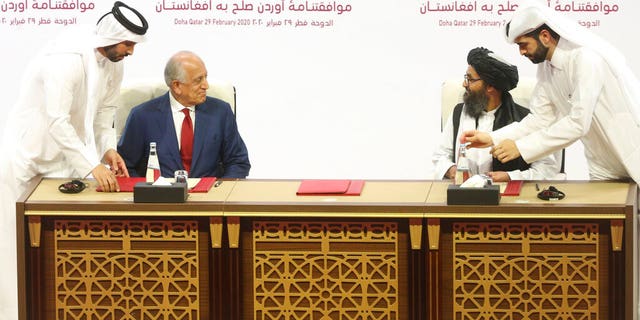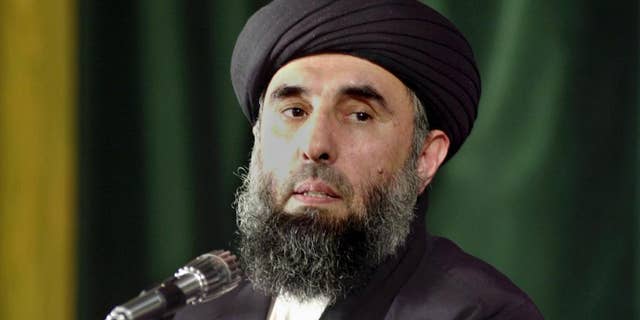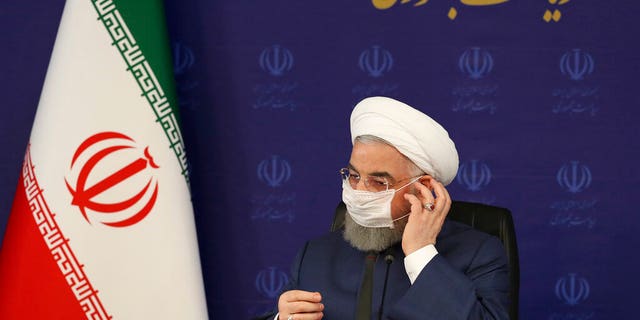Gone are the days that the Islamic Republic of Iran played Afghanistan war games in the shadows
As the United States draws down its troops from the conflict-beleaguered Afghanistan, cracks are emerging that neighboring Iran is entrenching itself into – shoring up ties with formal government officials and ethnic minorities, as well as the Taliban and disgruntled new Taliban offshoots.
Tufail Ahmad, a senior fellow for the Middle East Media Research Insitute (MEMRI) Islamism and Counter-Radicalization, told Fox News this week that Iran has been emboldened to create “cultural, political and strategic influence” inside its neighbor.
“[Iran] has engaged in targeted assassinations of Afghan officials. Iran sheltered Al Qaeda terrorists. Also, Iran’s relations with the Taliban are long standing and deep,” Ahmad continued. “Over the past decade, the Taliban delegations have visited Tehran many times, but the Iran-Taliban consultations became frequent in recent years as the U.S. engaged in negotiations with the Taliban.”
Over the past six months – ever since the U.S. inked a controversial “Peace Deal” with the Taliban in a bid to end the almost 19-year stalemate battle – a spin-off group of Taliban fighters opposed to the Washington agreement has formed. Called Hezb-e Walayat e-Islami, or Party of Islamic Guardianship, the outfit is believed to be based in Iran and is one of several splinter outfits relying on Tehran’s support for survival.

In 2018, the U.S. Treasury Department asserted that the Taliban’s former military commission chief, Ibrahim Sadr a designated global terrorist who now commands an even more hardline Taliban faction – was receiving covert “monetary support and individualized training” from Iran.
According to the Middle East Institute (M.E.I.), Hezb-e-Walayat is made up of multiple Sadr followers. And while not pointing fingers at Tehran specifically, even a United Nations report released in late May acknowledged that the offshoot “has been created outside Afghanistan.”
But inside Afghanistan, the Tehran-Taliban ties are no longer a taboo topic.
“We have ties with the Taliban, and they visited Iran, where we held meetings with them,” Abbas Araghchi, the political deputy at the Iranian Foreign Ministry, proclaimed in an interview with TOLOnews last month.
And in November, Taliban Politburo Chief Mullah Abdul Ghani Baradar visited Tehran and met with the Iran foreign minister, Javad Zarif, to discuss “Tehran’s readiness to facilitate the Intra Afghan Dialogue,” Iran’s Press TV reported.
That same month, the U.S. Defense Intelligence Agency (D.I.A.) unveiled a report alleging that Iran provides financial, political, training and material assistance to the Taliban.
“Tehran does not seek to return the Taliban to power but aims to maintain influence with the group as a hedge in the event that the Taliban gains a role in a future Afghan government,” the report stated, underscoring that Iran’s support enabled it to obtain “strategic depth” in the country.
In January, U.S. Secretary of State Mike Pompeo accused the Iranian regime of attempting to erode the peace process, stating that “the Taliban’s entanglement in Iran’s dirty work will only harm the Afghan peace process.” Yet the following month, the landmark accordance was affirmed.
“As the United States became a common enemy, relations between Iran and the Taliban improved day by day,” noted Hamid Aziz, a Kabul-based politics professor and former spokesperson for the Hezb-Islami political faction. “So much so that this trust grew to the point that the former Taliban leader – Mullah Akhtar Mohammad Mansour – traveled to Iran. The absence of Western forces in Afghanistan is a success and an opportunity for Iran.”

While religiously the relationship doesn’t fit, it has come to be something of a marriage of convenience – with an objective to undermine U.S. interests.
As a Shiite-majority nation, Iran has long been at odds with the Afghan Taliban, comprised almost entirely of devout adherers of Sunni Islam. Iran is said to have initially supported the U.S. mission to overthrow the Taliban government following the September 11, 2001, attacks. But as the U.S. and subsequent NATO footprint spread throughout Afghanistan in the years that followed, Iran reconstituted its Taliban relations – smuggling weaponry and allowing commanders to fund its insurgency through Iranian institutions.
What started as quiet abetment, Iran turned to the Taliban to inflict higher costs – in blood and treasure – that would eventually lead to ending the NATO mission.
“As Sunni extremists, the Taliban are not natural allies of Shiite Iran. Iran’s support for the Taliban today is largely a result of U.S. hostility to Iran, causing Tehran to seek avenues to push back against the U.S.,” explained Benjamin Friedman, a policy director at Defense Priorities. “Still, the Iran-Taliban relationship is not a smooth one; recently, Iran arrested 19 Afghans who flew the Taliban flag in Tehran.”
Experts also note that the Taliban – with a freshly signed U.S. deal that centered on the Taliban pledging not to provide a safe haven for international terrorist activities – is in the most potent position it has been since heralding over Kabul two decades ago. With tens of thousands of fighters among its ranks, an estimated territorial country of more than half Afghanistan, and the ongoing ability to launch deadly attacks on Afghan troops, analysts point to Iran’s backing as having been a crucial and steady hand.
Yet, according to Ahmad’s monitoring, “right through 18 months of U.S.-Taliban negotiations in Doha, the Taliban leaders were in consultation with Iranian officials.”
The United States sanctioned Iran’s IRGC-Quds Force in 2007 for providing weapons and financial support to the Taliban to use against U.S.-led coalition forces in Afghanistan.
Two years later, as brought to light in a 2009 report authored by the then commander of U.S. forces in Afghanistan Stanley McChrystal, the United States again pointed fingers at Iran for playing a deadly double game – on the one hand sneaking weapons to the Taliban to be used against the Afghan government, while at the same time cementing diplomatic relations with Kabul. In 2010, reports emerged that Iran was paying Taliban fighters $1,000 for every U.S. soldier killed.

(Iranian Presidency Office via AP)
Little has seemingly shifted when it comes to Iran’s ability to preserve favorable terms with almost all Afghan shareholders.
Tehran is a prominent source of foreign investment and aid when it comes to infrastructure, communications and agricultural development. Furthermore, Kabul and Tehran have a critical water-sharing agreement.
On this note, Barnett Koven, counterterrorism lead researcher at the National Consortium for the Study of Terrorism and Responses to Terrorism, observed that Tehran benefits from both stability and instability next door.
“Iran experiences water scarcity and currently imports fresh water from Afghanistan. Stability in Afghanistan leads to agricultural projects, including damming of waterways upriver from Iran. To add insult to injury, the United States government often funds these efforts,” he conjectured.
In terms of instability, Koven emphasized that Afghanistan is a significant source of black-market currency for Iran; thus, stability would bring tighter border security and threaten this access.
Iran has subsequently injected especially large sums of money into Afghanistan’s schools and mosques in the skirting western province of Herat and sought to support Afghanistan’s Shiite minority, the Hazaras, in what analysts deem a form of “soft power” and an effective way of ushering in some stability. In turn, Kabul has notably avoided criticism of any meddling by the country, of which it shares a 580-mile border.
In return, the Taliban has vowed to stop – or at least limit – its persecution of the Shiite minority and aspired to attain legitimacy among the maltreated group. In May, the Taliban even delegated Mahdi Mujahid, an ethnic Hazara Shiite cleric, as its northern district governor.
But adding to the murkiness of Tehran’s ambitions, numerous confirmed reports have surfaced in recent years that Tehran has forced embattled Hazaras to fight its proxy war alongside the Damascus regime in Syria.
Moreover, following the January assassination of Qassem Soleimani, Iran’s number-one “spy commander” and head of the notorious Islamic Revolutionary Guard Corps-Quds Force (IRGC-QF), some analysts contend that Tehran’s imprint has deepened since Gen. Esmail Ghaani was appointed Soleimani’s successor.
“Ghaani has a history of ties in Afghanistan dating back to the 1980s when he helped arm and support Shiite communities there on behalf of Iran,” said Josh Lipowsky, senior research analyst at the Counter Extremism Project (C.E.P.). “Ghaani’s influence has continued, as evidenced by a secretive 2018 meeting he had with the governor of Afghanistan’s Bamiyan Province. Ghaani allegedly introduced himself at the time as Iran’s deputy ambassador to Afghanistan.”
In late January this year, U.S. Marine General Frank McKenzie also warned of an increasing trend of Iranian interference on behalf of the Taliban in Afghanistan.
“For years, Iran has sought to increase its influence with the Taliban in order to weaken the United States globally,” Lipowsky asserted. “While the Taliban are not ideologically aligned with Iran and not as loyal as Hezbollah or the Iraqi militias, they will owe Iran for its support.” But the extent of that support is not fully known.

Moreover, Iran’s boosting of the Taliban and its diplomatic connections with Kabul are incentivized by the mutual desire to eradicate ISIS fighters from the region.
“Iran has developed a comprehensive relationship with the Taliban in the past few years since the emergence of I.S..S. Khorasan that covers political, security and economic spheres,” surmised Harun Najafizada, an analyst at the London-based Iran International TV.
Yet what becomes of the Taliban-Tehran coupling, and Iran’s more extensive engagement in Afghanistan as the United States heads for the exits, remains to be seen.
“Iran wants two things, to hedge on Afghanistan’s future by building ties on both sides of the civil war and to drive up U.S. costs to get U.S. forces off one of its borders. Geography ensures that Iran will always have an interest in Afghanistan,” Friedman said. “But Iran’s support for the Taliban is largely driven by antagonism with the U.S. So a U.S. withdrawal from Afghanistan would likely lessen, if not end, Iran’s support for the Taliban.”
